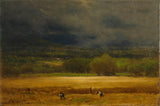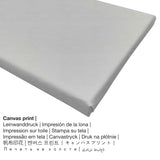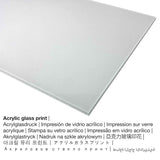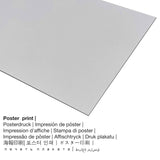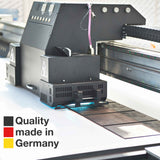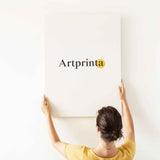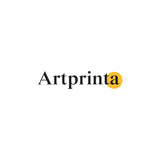George Inness, 1877 - Ubi Wheat - mbipụta nka mara mma
Ụtụ gụnyere. Mbupu gbakọrọ na ndenye ọpụpụ.
Ozi zuru ezu na akụkọ
N’afọ 1877 George Inness painted the 19th narị afọ nka a na-akpọ "The Wheat Field". Emere izizi ya na nha - Ekebereghị: 50,8 x 76 cm (20 x 29 15/16 na). Mmanụ na kwaaji was used by the North American artist as the technique for the piece of art. The painting has the following inscription: "signed lower lert: "G. Inness"". The work of art is part of the Ụlọ ihe ngosi nka nke Cleveland nchịkọta nka dijitalụ na Cleveland, Ohio, United States nke America. A na-enye ihe osise a, nke bụ nke ọha na eze site n'ikike nke Velọ ihe ngosi nka nke Cleveland. Ebe kredit nke ọrụ nka: Gift of Mr. and Mrs. Robert S. Copelin. Ọzọkwa, itinye n'ọnọdụ nke dijitalụ mmeputakwa bụ odida obodo na a akụkụ ruru nke 3: 2, nke pụtara na ogologo bụ 50% ogologo karịa obosara. George Inness was a male painter of American nationality, whose style was primarily Impressionism. The artist was born in 1825 and died at the age of 69 n'afọ 1894.
What does the curator team of the The Cleveland Museum of Art say about this artwork made by George Inness? (© - Ụlọ ihe ngosi nka nke Cleveland - www.clevelandart.org)
Inness began his career executing detailed, realistic landscapes in a style similar to other artists of the Hudson River School. After a series of trips to Europe, as well as growing involvement in Swedenborgianism--the spiritual doctrines of the theologian Emmanuel Swedenborg--Inness created increasingly free, mystical, and expansive paintings. This work was painted following a visit to France and Italy from 1870 to 1874, during what has been considered the most important phase of Inness’s career.
Nkọwa ahaziri nke ọrụ nka
| Akụkụ nka: | "The Wheat Field" |
| Nhazi nka nka: | sere |
| Otu sara mbara: | nkà nke oge a |
| Narị afọ nka: | 19th narị afọ |
| Afọ okike: | 1877 |
| Afọ nka: | gbara afọ 140 |
| Agba na: | mmanụ na kwaaji |
| Akụkụ izizi: | Ekebereghị: 50,8 x 76 cm (20 x 29 15/16 na) |
| Akara aka nka nka: | signed lower lert: "G. Inness" |
| Ụlọ ihe ngosi nka: | Velọ ihe ngosi nka nke Cleveland |
| Ebe ngosi nka: | Cleveland, Ohio, United States nke America |
| Weebụsaịtị nke ihe ngosi nka: | www.clevelandart.org |
| Licensedị ikike: | ngalaba ọha |
| Site n'aka: | Velọ ihe ngosi nka nke Cleveland |
| Ebe kredit nke ọrụ nka: | Gift of Mr. and Mrs. Robert S. Copelin |
Nyocha ngwa ngwa nke onye na-ese ihe
| aha: | George Inness |
| okike nke onye nka: | nwoke |
| Nationality: | American |
| Ọrụ: | onye na-ese ihe |
| Country: | United States |
| Nkewa onye nka: | omenkà nke oge a |
| Ụdị nke onye na-ese ihe: | Mmetụta |
| Afọ ọnwụ: | 69 afọ |
| A mụrụ: | 1825 |
| Nwụrụ n'afọ: | 1894 |
| Nwuru na (ebe): | Bridge nke Allan, Scotland |
Họrọ ụdị ihe onwunwe gị
In the product dropdown selection you can select your individual size and material. Pick your favorite material and size between the subsequent choices:
- Mbipụta iko acrylic na-egbuke egbuke (nke nwere ezigbo mkpuchi iko): An acrylic glass print, often referred to as a UV print on plexiglass, will change the original into wall décor and offers a viable alternative to canvas and dibond fine art prints.
- Mbipụta kanvas: A canvas direct print is a printed canvas mounted on a wooden frame. Besides, canvas print makes a nice, comfortable atmosphere. A canvas of your favorite artpiece will allow you to transform your new fine art print into a large artpiece as you know from art galleries. The great advantage of canvas prints is that they are relatively low in weight, which implies that it is easy and straightforward to hang up your Canvas print without any wall-mounts. Hence, a canvas print is suited for any kind of wall.
- Mbipụta nke aluminom: An Aluminium Dibond print is a print with a true depth effect. A direct Aluminium Dibond Print is the best start to fine art replicas on aluminum.
- Mpempe akwụkwọ (ihe kwaaji): The poster is a printed sheet of cotton canvas paper with a fine structure on the surface. The printed poster is ideally appropriate for putting the art replica with the help of a personal frame. Please note, that depending on the size of the poster we add a white margin between 2-6cm round about the print motif, which facilitates the framing with your custom frame.
Nkọwa ngwaahịa ahaziri ahazi
| Nkewa bipụta: | ezi nka mmeputakwa |
| Usoro mmeputakwa: | dijitalụ mmeputakwa |
| Produzọ mmepụta: | UV kpọmkwem obibi |
| Ihe ngosi: | German mmepụta |
| Ụdị ngwaahịa: | a na-achọ |
| Ngwaahịa were: | nka mgbidi, mgbidi gallery |
| Ndozi onyonyo: | usoro odida obodo |
| Njikwa oyiyi: | 3: 2 (ogologo: obosara) |
| Mmetụta akụkụ onyonyo: | ogologo bụ 50% ogologo karịa obosara |
| Nhọrọ dị: | ígwè obibi akwụkwọ (aluminium dibond), ebipụta canvas, mbipụta akwụkwọ mmado (akwụkwọ kwaaji), mbipụta iko acrylic (nwere ezigbo mkpuchi iko) |
| Mpempe akwa akwa (akwa akwa na etiti ihe ndọtị) nha: | 30x20cm - 12x8", 60x40cm - 24x16", 90x60cm - 35x24", 120x80cm - 47x31", 150x100cm - 59x39" |
| Mpempe iko acrylic (nwere ezigbo mkpuchi iko) nha: | 30x20cm - 12x8", 60x40cm - 24x16", 90x60cm - 35x24", 120x80cm - 47x31", 150x100cm - 59x39" |
| Nhọrọ nke mbipụta akwụkwọ mmado (akwụkwọ kwaaji): | 60x40cm - 24x16", 90x60cm - 35x24", 120x80cm - 47x31" |
| Mbipụta aluminom (aluminium dibond ihe) nha dị iche iche: | 30x20cm - 12x8", 60x40cm - 24x16", 90x60cm - 35x24", 120x80cm - 47x31" |
| Nhazi mbipụta nka: | enweghị etiti |
Disclaimer: We try everythig possible to depict our products as precisely as possible and to illustrate them visually. Nonetheless, some pigments of the printed materials and the printing can differ somehwat from the representation on the monitor. Depending on the settings of your screen and the condition of the surface, colors might not be printed one hundret percent realistically. Since all the art reproductions are processed and printed manually, there may as well be slight variations in the size and exact position of the motif.
Edochiri ederede a site na nwebiisinka © | Artprinta (www.artprinta.com)

